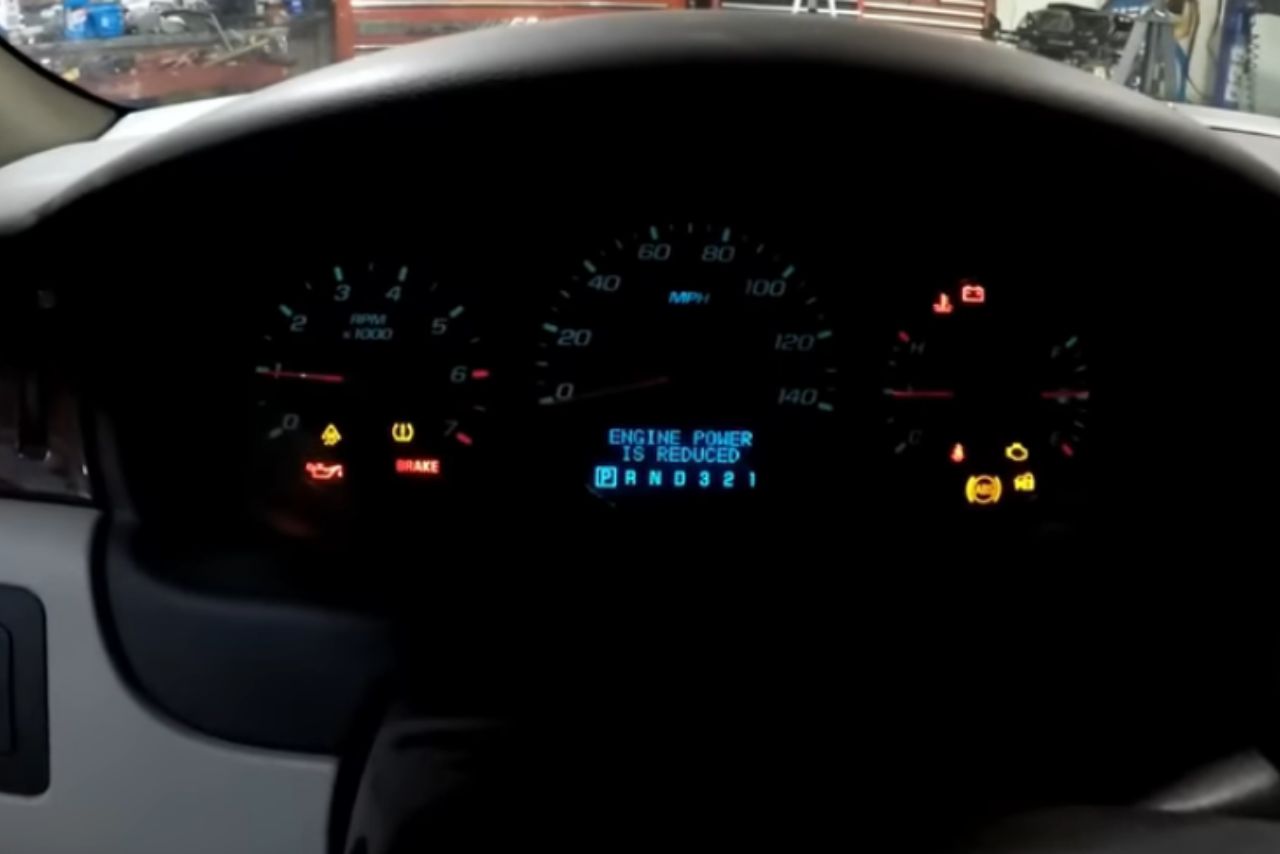Experiencing the “Engine Power is Reduced” warning on your Chevy Cruze can be quite concerning, but don’t fret.
This common issue may stem from several root causes – primarily malfunctions in the throttle body, accelerator pedal sensor, or engine control module which we’ll delve into shortly.
If your Chevy Cruze displays “Engine Power is Reduced,” it indicates a performance issue. Common causes include throttle body problems, sensor issues, or a malfunctioning electronic control module (ECM). Diagnose and address the specific issue promptly to restore optimal engine power.
As for fixing it? Often a professional diagnostic and repair service is your best bet to ensure safe and optimal performance of your vehicle.
Understanding these issues not only helps you diagnose the problem faster but might also save you some time at the mechanic’s shop.
So buckle up as we drive through this comprehensive guide about what causes an ‘Engine Power is Reduced’ alert in a Chevy Cruze and how to fix it.
Table of Contents
Common Causes of Engine Power is Reduced Chevy Cruze:

Engine power reduction is a common issue in Chevy Cruze. Here are some main causes:
Here’s a table that summarizes possible reasons and their symptoms:
| Cause | Symptoms |
|---|---|
| Faulty Throttle Body | Unstable idling, difficulty starting |
| Bad Oxygen Sensors | Check Engine light on, increased fuel consumption |
| Damaged Mass Air Flow Sensor | Rough running at idle |
Remember: Always consult with professionals for any repairs!
1. Faulty Mass Airflow Sensor:
The mass airflow sensor (MAF) plays a vital role in the functioning of a Chevy Cruze. If it’s faulty, you might face an “Engine Power is Reduced” warning. Here are some issues associated with a faulty MAF:
Causes of Faulty MAF:
Fixing a Faulty Mass Airflow Sensor:
You can either clean or replace the faulty component.
Cleaning The MAF
Replacing The MAF
If cleaning doesn’t work, consider replacing it entirely:
Step 1: Purchase a new mass airflow sensor compatible with your model.
Step 2: Follow your vehicle’s manual for step-by-step removal and replacement instructions.
| Warning | DIY repairs should only be undertaken if you’re confident in dealing with automobile mechanics. It’s always safer to take help from professional services if unsure about any steps.|
2. Clogged Fuel Injectors:
Clogged fuel injectors are a common cause for the “Engine Power is Reduced” message in Chevy Cruze. These tiny parts play a critical role in your vehicle’s performance, spraying fuel into the engine’s cylinders at high pressure.
Main Signs of Clogged Fuel Injectors:
A few reasons why these clogs happen include dirt and debris entering the fuel system or buildup over time from using low-quality gasoline.
How to Fix:
| Action | Prevents | Fixes |
|---|---|---|
| Regular maintenance | Yes | No |
| Using high-quality gasoline | Yes | No |
| Fuel injector cleaner additives | Yes | Mild Cases |
| Professional cleaning/replacement | No | Severe Cases |
Remember: regular preventive care will keep you on top of these issues before they become serious problems affecting engine performance!
3. Malfunctioning Oxygen Sensor:
The oxygen sensor, a vital component in your Chevy Cruze engine system, plays an essential role in maintaining the ideal air-fuel mixture. A malfunctioning sensor can lead to reduced engine power.
Here are the main causes and fixes:
Below is a table summarizing key indicators and solutions related to a malfunctioning Oxygen Sensor:
| Indicator | Solution |
|---|---|
| Check Engine Light On | Use OBD2 scanner for diagnosis |
| Rough Idle or Stalling | Inspect & clean/replace as necessary |
| Increased Emissions | Professional inspection recommended |
In case of any serious issues with your Chevy Cruze’s Oxygen Sensor:
- Seek professional help immediately
- Avoid driving until the problem gets fixed
- Consider replacing the entire unit if repairs aren’t possible
Remember, keeping your car’s components healthy helps avoid sudden drops in engine power performance!
4. Issues with the Spark Plugs:
Spark plugs play a huge role in the efficient functioning of your Chevy Cruze. When there’s an issue, you’ll likely notice reduced engine power. Here are some key points:
You might be wondering how often should you replace these? Ideally, it varies depending on usage but here’s a general guideline.
| Mileage | Action |
|---|---|
| <30,000 miles | Inspect |
| 30,000 – 60,000 miles | Replace if necessary |
| >60,000 miles | Definitely replace |
Here are steps on how to check your spark plugs:
- Locate your spark plug (check manual)
- Disconnect wire from one plug at a time
- Use a plug socket and ratchet to unscrew each plug.
- Inspect: Look for carbon build-up or damage
Remember: Always handle them carefully as they’re delicate pieces of hardware!
5. Problems with the Catalytic Converter:
The catalytic converter is a critical component in your Chevy Cruze’s exhaust system. If it fails, you might see an ‘Engine Power is Reduced’ message. Here are some common issues:
Here’s a brief comparison of symptoms for both these problems:
| Issue | Symptoms |
|---|---|
| Clogged Converter | Sluggish acceleration, decreased fuel efficiency |
| Broken/Damaged Converter | Rattling noises from under the car |
To address these issues:
- Use a high-quality fuel treatment: This helps clean out any build-up inside the catalytic converter.
- Regularly service your vehicle: Routine check-ups help detect early signs of damage to prevent complete failure.
- Replace if necessary: If there’s significant damage or clogging that cannot be cleaned, replacement may be required.
Remember, only professionals should handle replacing converters due to their complex nature and location within the vehicle!
6. Defective Throttle Position Sensor:

The throttle position sensor (TPS) plays a crucial role in regulating your Chevy Cruze’s engine power. If it malfunctions, you may encounter the ‘Engine Power is Reduced’ warning message. Here are the main causes and fixes:
Here’s how you can identify a defective TPS:
- Erratic Idle Speed
- Sudden Stalling
- Poor Acceleration Performance
And here’s a brief guide on replacing your vehicle’s TPS:
- Locate the throttle body by following air intake system from air filter box.
- Unplug electrical connector from old sensor.
- Unscrew mounting bolts holding sensor onto throttle body.
- Install new sensor in reverse order of removal steps.
| Symptoms | Potential Fixes |
|---|---|
| Erratic Idle Speed | Replace/Recalibrate Sensor |
| Sudden Stalling | Check for Faulty Wiring |
| Poor Acceleration Performance | Replace Throttle Body |
Keep these points handy next time when that pesky ‘Engine Power is Reduced’ light illuminates due to a defective Throttle Position Sensor!
7. Dirty or Low Engine Oil Levels:
Dirty or low engine oil levels can trigger the “Engine Power is Reduced” warning on your Chevy Cruze. Here’s why:
To check your car’s engine oil level:
| Oil Level | |
|---|---|
| OK | Between MIN & MAX marks |
| Low | Below MIN mark |
For quality assurance:
- Use only manufacturer-recommended oils
- Change your vehicle’s engine oil at regular intervals as per manufacturer guidelines.
If you’ve topped up or changed your car’s engine oil but still get this warning message, seek professional help immediately; there might be a bigger underlying issue.
Remember: Regular maintenance checks keep your Chevy Cruze running smoothly while preventing costly future repairs!
8. Blocked Air Filter:
A blocked air filter can considerably reduce your Chevy Cruze’s engine power. It is one of the primary elements in the car’s intake system and plays a vital role in ensuring optimal performance.
Main Causes:
Impact:
When faced with a clogged air filter, your vehicle may exhibit symptoms like reduced horsepower, black smoke from exhaust or unusual engine noises.
Fixing A Blocked Air Filter:
| Step | Process |
|---|---|
| 1 | Remove old filter |
| 2 | Clean housing compartment |
| 3 | Install new filter |
Note: Always ensure that you are using quality filters compatible with Chevy Cruze models for maximum efficacy!
Steps to Fix Engine Power Reduction in Chevy Cruze:

The “Engine Power is Reduced” warning on your Chevy Cruze can be a frustrating problem. Here are some steps you can take to fix it:
Check the Throttle Body:
A dirty or malfunctioning throttle body may cause this error message.
- Clean the throttle body using a throttle body cleaner.
- If cleaning doesn’t work, consider replacing it.
Inspect Wiring Harness Connections:
- Check for loose connections or corroded wires.
- Replace any damaged parts.
Replace Accelerator Pedal Position Sensor (APP):
- The APP sensor measures how much gas you’re giving the vehicle.
Change Fuel Filter:
- A clogged fuel filter reduces the amount of fuel that reaches your engine, leading to power reduction.
Visit Your Mechanic:
- If none of these DIY methods work, schedule an appointment with a professional mechanic.
- Faulty sensors could lead to reduced engine power.
| Steps | Components |
|---|---|
| 1 | Throttle Body |
| 2 | Wiring Harness Connections |
| 3 | Accelerator Pedal Position Sensor (APP) |
| 4 | Fuel Filter |
| 5 | Professional Mechanic |
Remember that working on vehicles can be dangerous if not done correctly and always prioritize safety!
Watch this video to fix this issue:
Conclusion and final thoughts
Chevy Cruze, despite its impressive features and reliable performance, can occasionally display an ‘Engine Power is Reduced’ warning. The main causes include a faulty throttle body, accelerator pedal, or mass airflow sensor.
However, with correct diagnosis and prompt response to these issues, you can restore your vehicle’s optimal function.
Remember that regular maintenance of your Chevy Cruze should not be overlooked. By doing so, potential problems linked to reduced engine power can be identified early and resolved promptly.
Always consult a professional mechanic for any major repairs to ensure the longevity of your vehicle’s performance.
Latest Posts:
- Can WD-40 Remove Scratches on Cars? (Hint: Yes, but…)
- Can You Use a Drill to Polish Your Car? (We Tried it Out!)
- Should You Cover Car Scratches With Stickers? (REVEALED!)
- Buick Service Stabilitrak: (Causes & 100% Guaranteed Fix!)
- Common Holden Trax Problems (Causes & 100% Proven Fixes!)
- Jeep Commander Transmission Over Temp: (Guaranteed Fix!)












Leave a Reply